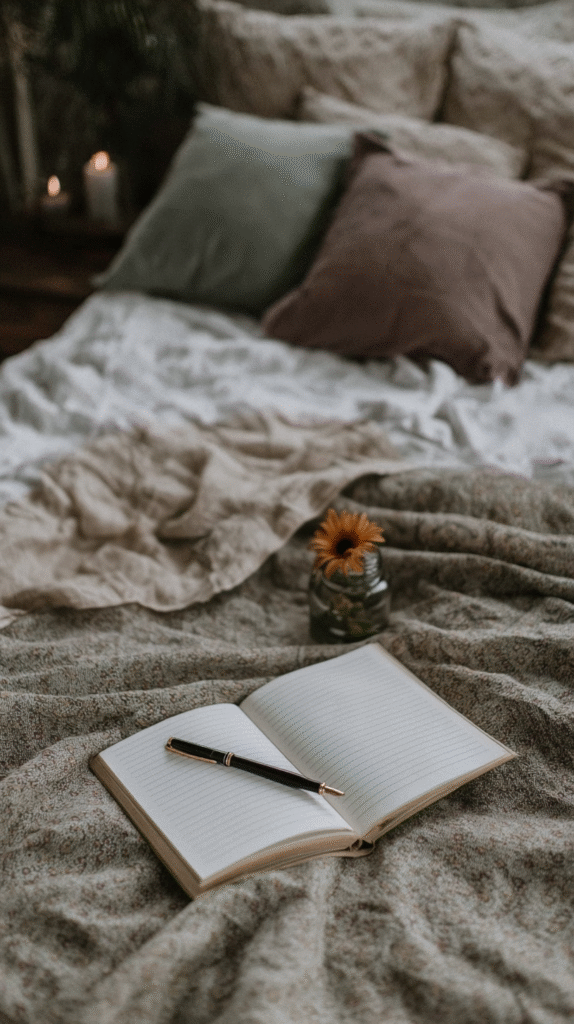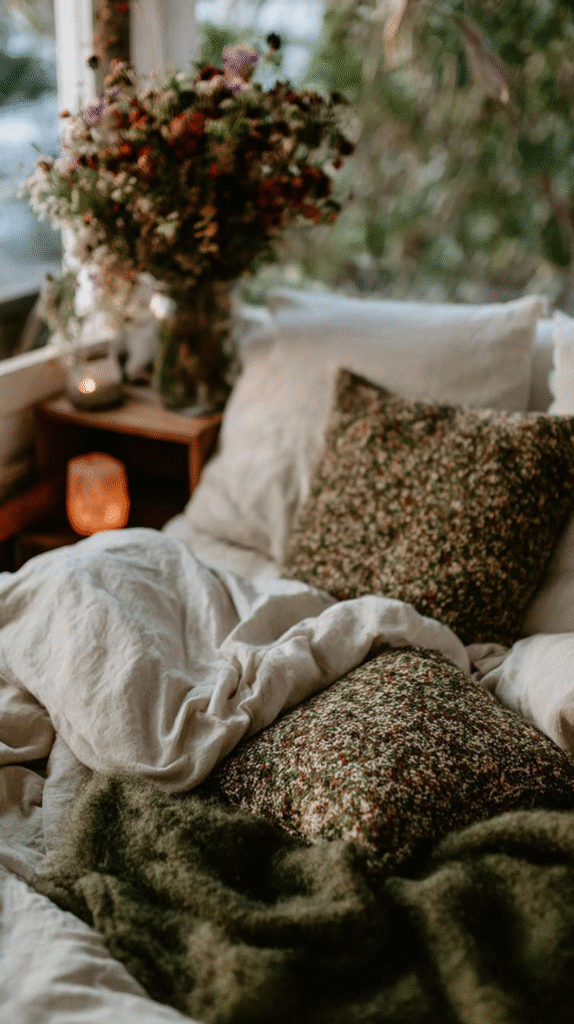This post may contain affiliate links, including those from Amazon Associates. If you make a purchase through these links, I may earn a commission at no additional cost to you. Learn more about our affiliate policy.
A consistent bedtime rhythm does more than signal sleep, it helps regulate the body’s internal clock and calms an overstimulated mind.
Research shows that slowing down in the hour before bed can lower cortisol levels, reduce anxiety, and improve sleep quality.
For the modern woman, it’s often not the day’s demands that exhaust us most, but the mental noise that continues long after the lights are out.
Creating small, intentional rituals tells your body, “You are safe now. It’s time to rest.”
A bedtime ritual doesn’t need to feel strict or perfect. Think of it as an act of devotion to yourself, a way to ground your energy, reset your thoughts, and remind your system that peace is available.
To deepen your evening rhythm, explore these 10 cozy evening routines that help calm your nervous system for inspiration on how to unwind with presence and intention.

Gentle Stretch and Breath
Tension builds up quietly through the day. Releasing it before bed helps your body transition from alertness to calm.
Spend five minutes stretching slowly; roll your shoulders, twist softly at the waist, and reach your arms overhead. Pair each movement with a long, conscious exhale.
The goal isn’t to “work out” but to loosen and let go.
Even two or three stretches paired with slow breathing can bring you into a grounded state. Keep a small yoga mat or rug beside your bed as a cue that it’s time to unwind.
Grounding Through Touch

Grounding helps shift energy out of the mind and back into the body. If possible, step outside barefoot for a minute before bed, feeling the earth, stone, or grass underfoot.
If it’s too cold, simply stand still indoors and imagine roots extending from your feet into the ground.
Notice the temperature of the floor, the texture beneath you, and the air on your skin. Allow your awareness to settle downward. This sensory grounding brings the nervous system into a sense of safety and stability, the foundation for deep sleep.
For apartment dwellers, place your feet on a wool rug or hold a smooth stone or crystal as you breathe. Connection happens through intention as much as location.
A Screen-Free Wind-Down
Scrolling before bed overstimulates the brain and delays melatonin release, keeping you alert long after you intend to sleep. Create a small “no-screen window” at least 30 minutes before bed.
Use this time for activities that don’t involve technology like reading, journaling, stretching, or listening to calming music. Keep a lamp on your nightstand and dim overhead lights to help your body register that it’s evening.
If this feels difficult at first, put your phone on airplane mode and leave it in another room. Replace it with something that feels soothing like a stack of books, a candle, or a soft blanket waiting for you.
If you struggle to slow down at night, practicing a few of these simple ways to reset your nervous system by connecting with nature can help your body remember its natural calm.
Herbal Tea or Warm Drink Ritual

A warm drink slows everything down. Chamomile, lemon balm, or lavender teas are naturally calming, but even warm water with honey can soothe the body and mind.
As you sip, notice the warmth traveling down your throat. Let it become a mindfulness practice: breathe, sip, pause. This ritual helps your nervous system associate warmth and stillness with safety.
Use your favorite mug, and if it feels comforting, light a small candle nearby. The combination of scent, warmth, and flickering light naturally lowers stimulation and signals to your body that it’s time to rest.
Scent and Sound Ambience
Our senses remember what safety feels like. Incorporating scent or sound helps anchor the body in calmness. Use a diffuser with essential oils like cedarwood, frankincense, or lavender, or simply add a few drops to a tissue beside your pillow.
Soft sounds can have the same grounding effect. Try rain or ocean waves, instrumental music, or a guided relaxation track. Choose one sensory cue and use it consistently each night, your body will start associating it with rest.
Keep volume low and lights dim. The goal is not stimulation but gentle sensory grounding.
Cozy Warm-Down
Warmth helps relax muscles and prepare your body for the cooling phase that signals sleep. Take a short bath or a simple foot soak with a handful of sea salt or a few drops of calming oil. If you’re short on time, slip into soft socks warmed near a heater or hot water bottle.
This warmth encourages circulation and eases the day’s tension. It also creates a sense of care—something often missing from our rushed evenings.
Make this five or ten minutes of transition sacred. No multitasking, no phone. Just warmth, scent, and quiet.
Journaling or Thought Release

A busy mind can make even the coziest bed feel restless. Before turning out the light, write down any lingering thoughts, plans, or emotions from the day.
Try two prompts: one thing you’re grateful for, and one thing you’re ready to release. The act of putting it on paper helps the brain let go. You no longer have to hold it all in your head.
Keep your journal beside the bed and let it be messy or brief. The goal is not productivity but peace. Over time, this practice becomes a mental clearing ritual, a way of setting down the day’s weight before sleep.
Mindful Body Scan
Once you’re in bed, take a few slow breaths and bring attention to your body. Starting at your toes, notice each part of yourself without judgment. Invite every muscle to soften, feet, legs, stomach, shoulders, jaw.
Imagine your breath as warm light traveling through the body, releasing tension as it goes. If your mind drifts, return to the rhythm of breath and the sensation of the mattress beneath you.
This simple awareness exercise can quiet the mind faster than forcing yourself to “fall asleep.” It reminds your body that it’s supported, safe, and home.
Consistent Bedtime and Environment

Your body loves rhythm. Going to bed and waking up around the same time each day helps stabilize your internal clock, which naturally improves sleep quality.
Keep your bedroom dark, cool, and uncluttered. Reserve it for rest and intimacy, not work or stress. Dim lamps instead of bright overhead lighting, and keep the temperature slightly cool so your body can ease into deeper stages of sleep.
If you live in a small space, even small changes help. An eye mask, a white noise app, or clean sheets with a natural scent can shift the entire mood of a room.
Consistency is what teaches your body that this space, and this time, means rest.
Building a Routine You’ll Keep
Start small. Choose two or three rituals that fit naturally into your evenings. Maybe a warm drink and journaling one night, a stretch and foot soak the next. Over time, they’ll blend together into a rhythm that feels effortless.
You can also keep a small “evening basket” by your bedside: herbal tea packets, a book, lavender oil, a sleep mask. This keeps your rituals within reach and eliminates decision fatigue.
Your goal isn’t perfection, it’s consistency and calm. Let your routine become something you look forward to, a soft closing chapter after a long day.
Overcoming Common Barriers
If your mind won’t stop racing, use journaling or a body scan instead of trying to “force” sleep.
If you’re too tired for much effort, just do one thing like make a cup of tea, take a few deep breaths, or slip into cozy socks. Even the smallest act tells your body that it’s safe to rest.
If your space isn’t ideal, remember that rest comes from within. Lower the lights, tidy a small corner, and let that be your sanctuary. Don’t compare your evenings to curated routines online. Your rhythm is your own, and that makes it sacred.
Closing Reflection
A good night’s sleep isn’t only about health—it’s an act of alignment. When you ground your energy before bed, you’re teaching your body and spirit to trust again. You remind yourself that the world will keep turning while you rest, that you don’t have to hold everything overnight.
Start with one simple ritual tonight. Maybe stretch, breathe, and light a candle. Let that moment mark your return to stillness. Over time, these small acts of care become a powerful signal to your body: the day is done, and peace is allowed.
The rhythm of rest is already inside you. All you’re doing is listening.



